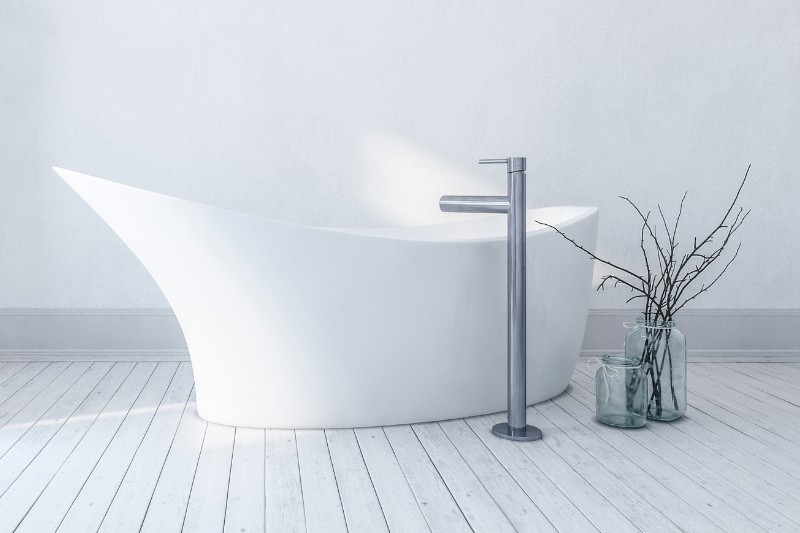A freestanding bath adds a touch of luxury to any bathroom by creating a beautiful centrepiece for relaxation.
Unfortunately, the process of cleaning these bathtubs is challenging. Not only do you have to remove the soap scum inside your bath, but you also have to remove grime from the bath exterior.
In many cases, the gap between a freestanding tub and the surrounding walls is quite small, making this task seem near impossible. Thankfully, cleaning inside these small spaces can be done, provided you have the right tools and equipment.
In this article, we teach you how to clean around a freestanding bath with ease. You’ll be given a rundown of the necessary methods to keep your tub looking fresh and tidy, as well as some helpful information about installing a freestanding tub so that cleaning future cleaning is easier still.
Are Freestanding Baths Easy to Clean?

There’s no doubt that freestanding bathtubs are generally much harder to clean compared to regular alcove tubs. This is because most freestanding baths cannot be placed directly against a wall, so dirt and debris accumulate in the hard-to-reach gaps around the tub.
If you’re lucky enough to have a large bathroom that can fit a bathtub in the centre, you can clean your bath with minimal effort.
As the sides are all easily accessible, you can walk around the tub and clean them as you would the inside of the bath. You can even use the same cleaning products.
Unfortunately, many freestanding tubs will have to be placed close to a bathroom wall to fit in the room. This leaves you with a narrow space that is difficult to clean.
Tubs with clawed feet will also need to be cleaned underneath, which can be an issue if you can’t freely move around the bathtub.
How to Clean Around a Freestanding Tub
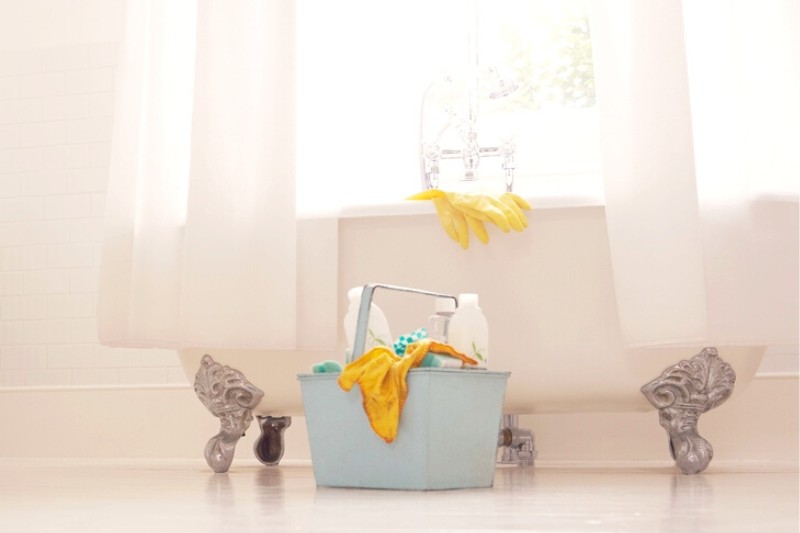
Thankfully, there is an easy solution to both the aforementioned problems with cleaning around a freestanding tub: purchase a long-handled scrubber and an extendable dusting tool that can be used to reach into these awkward spaces!
Here’s how to do it:
- Firstly, use the duster or a long hoover attachment to remove any loose debris from under the bathtub or around the feet.
- Then use the scrubber to apply your chosen cleaner to the hidden exterior surfaces. Rinse off, using a clean scrubber to access all the hard-to-reach places.
The type of cleaner we suggest you use for your bath will vary depending on the material it is made of. Below are some of our recommendations for cleaning a stone, cast iron, or acrylic tub.
Cleaning around a stone bath
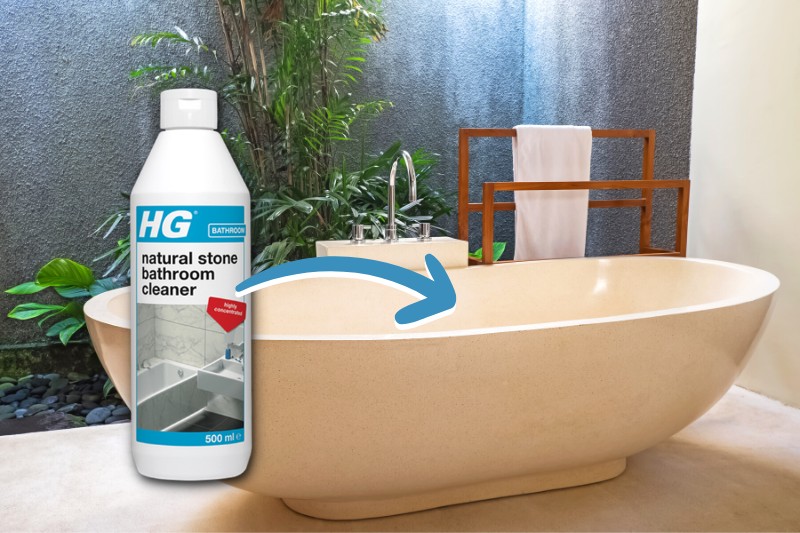
When cleaning a stone bath, you should avoid harsh cleaners such as bleach, ammonia, and vinegar, which will react with the stone and cause irreparable damage.
If contact occurs, rinse the cleaner away immediately to reduce the damage done. Therefore, you should stick with using one of the following cleaners:
- Stone cleaner: The safest type of bathroom cleaner to use on these bathtubs are ones specifically formulated for use on stone. For example, the HG Natural Stone Bathroom Cleaner is very highly rated by users and can be used on stone flooring, tiles, and bathroom fixtures. Simply apply it directly to a damp scrubber and use it to gently wipe away any grime from the outside of the tub.
- Abrasive cream cleaner: Your other option is to find a mildly abrasive cream cleaner. These are typically less damaging than other bathroom cleaners and are unlikely to react with your tub when applied to the stone.
Always ensure you do a patch test before using a new cleaner on your stone bathtub exterior to ensure that no damage will occur.
You also need to rinse any cleaning residue from your bath after use and wipe away any remaining moisture to avoid the formation of limescale.
Cleaning around a cast iron bath
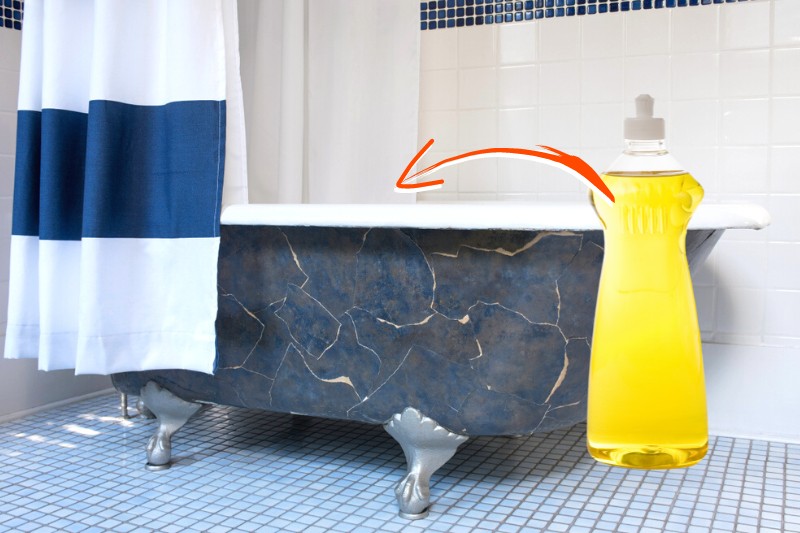
When cleaning a cast iron bath, you also have to be extremely careful which cleaner you use. Overly acidic cleaners will quickly wear away at the tub, while certain chemicals could cause discolouration.
Unfortunately, this means that many generic bathroom cleaners will not be suitable. However, a variety of cleaners are formulated for specific use on cast iron.
We suggest purchasing one of these or trying one of the homemade cleaners below:
- Washing up liquid: Simply apply a little washing up liquid directly to a damp extended scrubber. Rub the cleaner over the exterior surface of your tub and then repeat with clean water to rinse away the soapy residue.
- Washing up liquid and bicarbonate of soda: Mix together 240ml of hot water, one teaspoon of washing up liquid, and three tablespoons of bicarbonate of soda to create your cleaner. Apply a generous amount to the end of your scrubber and use it to remove any build-up. Afterwards, wipe away the dirty residue using clean water.
Cleaning around an acrylic bath
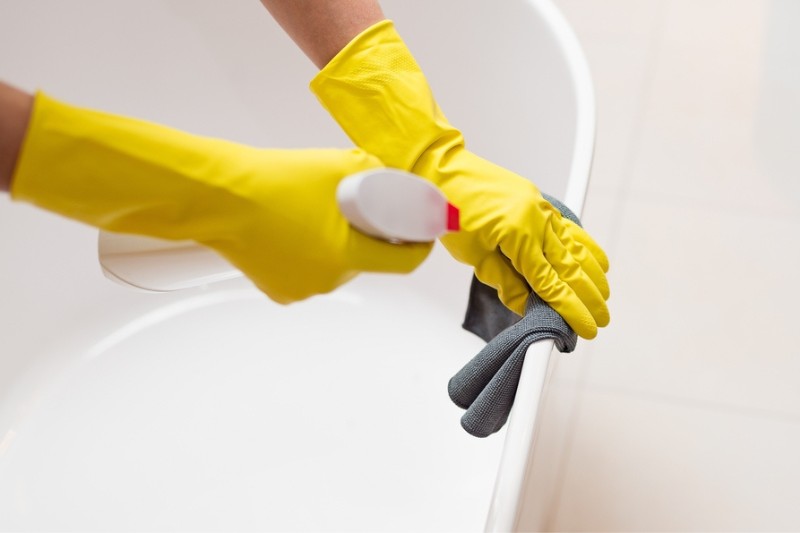
When cleaning an acrylic bath, it is important to avoid using an abrasive scrubbing pad and any extremely harsh chemicals. Both of these can damage the acrylic and cause deep scratches to form.
Thankfully, most store-bought bath cleaners will be safe to use, but we recommend always reading the packaging first just to be safe.
Alternatively, you can try using one of the homemade cleaners from the list below:
- Washing up liquid: Wet your extended scrubber and add a little washing up liquid to the sponge. Gently use the end to scrub any build-up from your bath, and then do the same with clean water to rinse.
- Bicarbonate of soda and hydrogen peroxide: Combine one part hydrogen peroxide with two parts bicarbonate to create a cleaning paste. Apply to your tub and leave to sit for 30 minutes before rinsing it away with a damp scrubber. Ensure you wear gloves when working with the paste and do a patch test before applying the cleaner to the entirety of the bath.
- Diluted bleach: Mix one part bleach with two parts hot water to create a cleaning solution. Dip your extended scrubber into the liquid and use it to wipe away any dirt and grime. Repeat with clean water to remove any residue and then leave to dry. Always use gloves when working with bleach to protect your hands.
How Far From the Wall Should a Freestanding Bath Be?
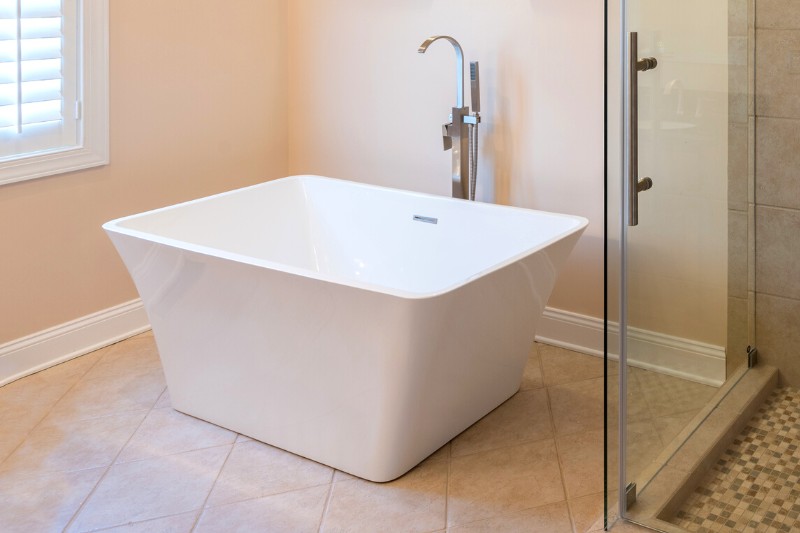
When positioning a freestanding tub in your bathroom, it’s important that you leave enough room around the edges to make cleaning easier.
As a general rule, we suggest leaving at least 30 cm of space between your bath and any of the surrounding walls to allow for easy access. However, the larger the gap you leave, the easier it will be to clean.
If possible, it would be best to have your bath standing in the middle of your bathroom so that you can easily walk around the whole tub and clean the sides without any specialised tools. Unfortunately, this will not be an option if you have a smaller bathroom.
In this case, you may benefit from purchasing a “back to wall” freestanding bath. These tubs have a flat edge that can be pushed flush against the wall, so you only have to worry about spacing on the two ends of the bath.
When a tub is pressed fully against the wall in this way, it will be impossible for any water, dirt, or grime to fall between the wall and the bathtub. This means that you don’t need to worry about cleaning this edge of the tub, so the lack of a gap will not matter.
Should You Silicone Around a Freestanding Bath?
![]()
When an alcove bathtub is fitted, it is typically edged with a silicone sealant. This creates an airtight, waterproof seal between the tub, the floor, and the surrounding walls.
Because freestanding baths often stand in the middle of your bathroom, they don’t always need to be sealed in the same way.
However, those with a flat base do need to be sealed to the floor to prevent water from becoming trapped underneath.
If this does occur, harmful mould may start to form. This can cause a variety of health issues and a musty odour in your bathroom.
If you own a “back to wall” freestanding bath, we also recommend you use a silicone sealant along the flat edge. This will once again prevent any water from becoming trapped between the tub and the wall, which could cause mould to grow.

Hannah has a passion for cleaning. She worked her way around Australia by cleaning hostels in exchange for free accommodation and used her cleaning skills to bag a job as a chalet host for a luxury ski company in France.
